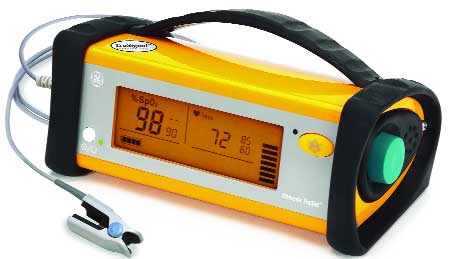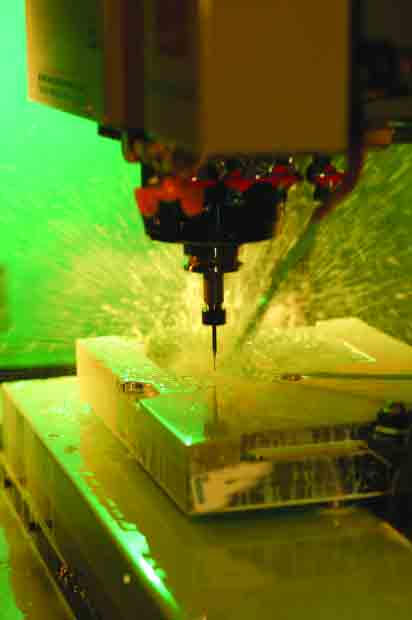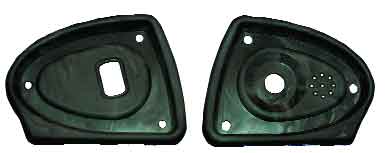Saving Time, not Cutting Corners
Rapid injection molding shortens the design cycle and improves prototyping for a time-pressed medical manufacturer.
Latest News
May 25, 2007
By Greg Kagan
Medical devices are subject to rigorous testing and product evaluation even before being submitted for clinical trials. To help offset the time required for testing and certification processes, developers are always looking for ways to speed up the processes of design and development. This was precisely the challenge facing design engineers at GE Healthcare when they were building a prototype for a new pulse oximeter. The device is used by medical clinicians in a broad range of environments — intensive care, operating rooms, emergency rooms, and even veterinary medicine — to monitor and analyze the delivery of oxygen to a patient’s tissues.
|
In developing the TruSat pulse oximeter, GE Healthcare engineers explored rapid injection molding to create the oximeter’s external bumpers. They used the process to evaluate three prototype batches within 10 days for each order — seven times faster than traditional molding methods. |
Engineers at the company’s Colorado facility were developing a compact, tabletop device. The TruSat pulse oximeter was designed to be more durable and easier to use than similar products already on the market. After designing the oximeter’s components, GE Healthcare engineers faced the daunting product-testing and approval process and evaluation required by U.S. and foreign regulatory agencies. To complicate the process, the engineers were under pressure to complete the necessary testing and approval in a limited time.
“Our number-one product development challenge is simple: reduce cycle time, period,” said Chris Crowley, program manager at GE Healthcare. “In the medical device industry, reducing cycle time is difficult because we also need to manage the approval processes required by each country’s regulatory agency. To help meet this challenge, we’re always looking for ways to cut down the front-end time it takes to get us to the regulatory testing and approval steps.”
 |  |
| The TruSat pulse oximeter is designed to be more durable and easier to use than similar products and provides early information on problems regarding oxygen delivery to a patient’s tissues. While waiting on the steel production molds, engineers used rapid injection molding to manufacture about 500 parts — allowing them to introduce the product to market and satisfy end-user demand immediately. | |
Uncovering an Innovative Solution
In developing the TruSat pulse oximeter, engineers explored a new prototyping process for creating the oximeter’s protective bumpers — external plastic parts that hold the device in place on a tabletop during use and help provide access to external connections.
“When it comes to creating prototypes, we traditionally create stereolithography masters and then pour a silicone mold, which can generate around 20 urethane castings for prototypes,” Crowley said. “Urethane parts generally look ‘realish’ from a distance, but that’s about as real as they get. They don’t use the same material or have the same color or feel as the final product. And customer prospects at trade shows can definitely tell there’s a quality difference.”
| Pulse Oximeter Primer Pulse oximeters provide clinicians with a noninvasive method of monitoring the percentage of oxygenated hemoglobin (Hb) in the bloodstream, testing a patient’s entire respiratory system with one simple measurement. The devices generally use a probe attached to the patient’s finger or earlobe to monitor the percentage of oxygen in the blood. |
Working with prototypes made of different materials than those used in production is an obvious handicap when demonstrating a product to potential customers. It also rules out even basic product testing. For example, in the case of the oximeter prototype, one initial test involved simply setting the device on the table and pushing buttons to determine if the bumper design would keep it from sliding across a smooth surface. The engineers recognized immediately that the hard urethane bumpers would slide during these simple grip tests and that they certainly couldn’t pass more rigorous tests like flame resistance.
They needed prototypes made of a specific resin to perform certification tests, so they turned to The Protomold Company of Maple Plain, MN. Protomold’s rapid injection molding process uses proprietary software and high-speed computer numeric-controlled (CNC) machining to produce injection-molded parts from 3D CAD models in as little as three days.
GE Healthcare engineers submitted 3D CAD design files for the oximeter’s outside bumpers online and received an interactive design analysis and quote within 24 hours. ProtoQuote, Protomold’s web-based analysis and quotation system, points out potential design improvements and provides price quotes based on the user’s choice of resins, lead time, finish, and quantity of parts to be produced. The decision to use Protomold saved GE Healthcare significant time and money over the cost of conventional tooling.
“We were amazed at how easy the ProtoQuote system was to use and the real–time functionality of it,” Crowley said. “Using the online quoting tool, we were able to interactively select different materials, lead times, and surface finishes and watch the price adjust in real time. This was a huge help in moving the process forward rapidly, especially since quotes using traditional methods generally could take anywhere from a few days to a week.”
Feedback from ProtoQuote also served as a final design check for GE Healthcare engineers, highlighting undercuts that would have been difficult or expensive to produce in injection molds and areas that needed drafts to allow parts to be cleanly ejected from their molds. ProtoQuote showed precisely where adjustments would facilitate molding and ejection. The highlighted areas were easily changed, and engineers placed an order for the first batch of bumper test parts.
 GE Healthcare engineers took advantage of Protomold’s rapid injection molding process to manufacture the TruSat’s outside bumper in a customized, flame-retardant material. |
Finding the Right Materials is Key
Over several weeks of testing, GE Healthcare engineers ordered three sets of parts, using different materials and design specifications. The team had its first set of parts in hand within 10 days after the initial order. When the initial combination of resin and a chemical additive failed GE Healthcare’s internal flammability testing, a second order was placed for prototypes in a different flame-retardant chemistry.
“To pass flammability tests, we needed a unique material mixture that isn’t regularly stocked by prototype manufacturers,” Crowley said. “Helping us with our special request wasn’t a problem for Protomold. We bought the required material and had it shipped to Protomold. The company was able to integrate it into their molding process and make our second set of parts without a problem.”
After a successful flammability test with the second batch of parts, GE Healthcare engineers placed a third order, incorporating final design adjustments and color specifications. Because the last batch of parts used production-grade materials, the engineers were able to begin final product testing to ensure that parts would be ready for external approval and certification.
The parts proved robust enough to withstand strenuous tests, such as chemical resistance, where the bumper is cut into sections and each section is soaked in cleaning solutions and antiseptics regularly used in hospitals. The ability to test for such conditions enabled GE Healthcare engineers to draw reliable conclusions regarding the product’s properties.
“Using rapid injection molding from the start allowed us to modify and finalize our design in the time it would have taken a traditional molder to create the first steel mold,” Crowley said. “This time savings had a huge impact on our development cycle. We had our first batch of completed prototype parts in hand for review even before receiving the first quote from our traditional molder.”
Reducing the Risk
Engineers estimate that traditional injection molding for this project would have cost GE Healthcare around $60,000 and taken nine to 10 weeks for delivery of each batch of parts. With rapid injection molding, the company was able to evaluate three separate part batches for about $3,000 each in just 10 days — a reduction of about 85 percent in both cost and time over traditional molding methods.
“Protomold’s ability to produce production-grade prototypes so quickly and at such a low cost was crucial to this project’s success,” Crowley said. “If we had discovered that our design and materials iterations required another new mold, we would have added only a few thousand dollars and a few days to our production cycle with rapid injection molding. Conversely, if we’d chosen traditional injection molding, the trade-off would have been a disaster, setting us back months and adding tens of thousands of dollars to our budget.”
The rapid injection molding process also helped bridge the gap between development and marketing. While waiting on the steel production molds, engineers were able to order approximately 500 parts from Protomold, allowing them to introduce the product to the market earlier and satisfy immediate end-user demand.
“The wait for steel molds could have put a halt to our production efforts,” Crowley said, “but we knew that rapid injection molding could provide us with an affordable low-volume run of production parts.”
More Information
The Protomold Company
Maple Plain, MN
protomold.com
GE Healthcare
Chalfont St. Giles, UK
gehealthcare.com
Greg Kagan is a Minnesota-based freelance writer focusing on technology and industrial processes. To send an e-mail about this article, click here.
Subscribe to our FREE magazine, FREE email newsletters or both!
Latest News
About the Author
DE’s editors contribute news and new product announcements to Digital Engineering.
Press releases may be sent to them via [email protected].







